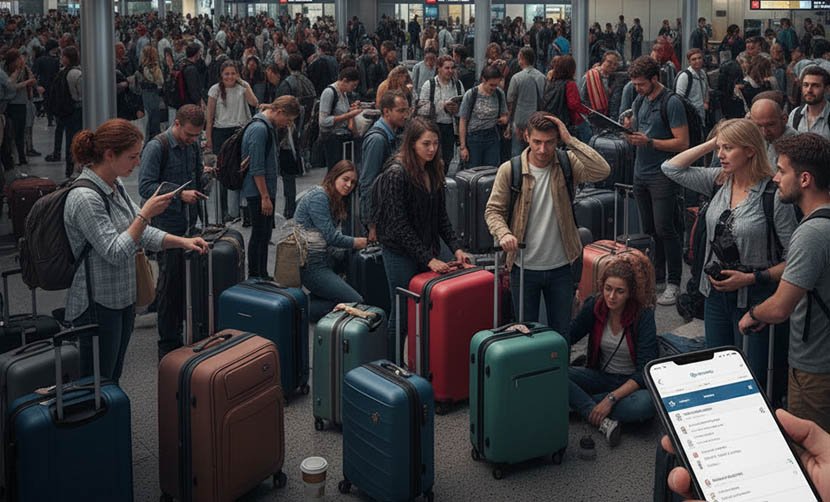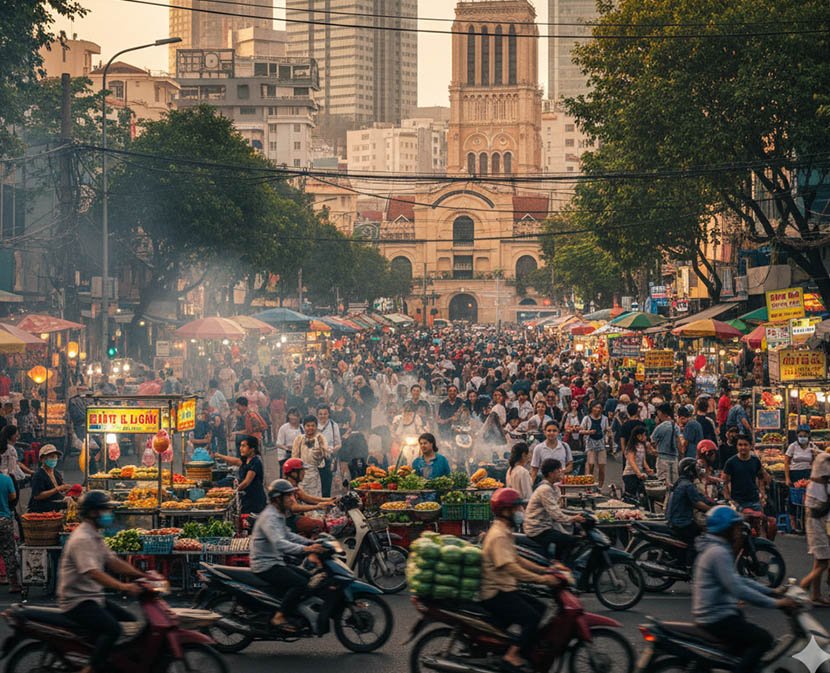Michael and I are longtime digital nomads who have spent much of 2025 in Asia, and now we’re in Hong Kong, arguably the third most important financial center in the world, after New York and London.
And to our surprise, we’re not loving it.
Hong Kong is, of course, a small area on the coast of the South China Sea made up of three different “regions”: Kowloon and the New Territories, both on the Chinese mainland, and Hong Kong Island.
It’s also home to 7.4 million people, making it one of the most densely populated places on Earth.
But what is it exactly?
It’s not a country, it’s not a city-state like Singapore, and it’s not part of China either — not exactly.
For a long time, it was part of the Chinese Empire, but honestly, it wasn’t much: just some farms and fishing villages. In the early 17th century, it was briefly a Portuguese trading port, but then the whole area was cleared of people during something called the Great Clearance, when China banned all maritime trade.
After the First and Second Opium Wars with Britain, China ceded the area to the UK, which established a colony. It rapidly became a major trading center — and also attracted many refugees from China.
In the 20th century, after World War II and the Chinese Communist Party took over mainland China, Hong Kong became even more prosperous; it was soon deemed one of the four economic powerhouses in this area of the world known as the “Asian Tigers,” along with Singapore, South Korea, and Taiwan.
In 1984, Britain agreed to return control of Hong Kong to China — and it did, in 1997, with an agreement that also established Hong Kong’s more “free” political and economic systems would be maintained for at least fifty years after the handover.
These days, Hong Kong is considered a “Special Administrative Region” (or “SAR”) of the People’s Republic of China, which calls Hong Kong an example of their “one country, two systems” principle.
The reality is a bit complicated.
On one hand, there is a very hard border between mainland China and Hong Kong. The customs and immigration systems are entirely different.
Hong Kong also uses its own currency — the Hong Kong dollar — and has its own legal and judicial system, based on British law. And it elects and controls the local government — kind of. China has intervened over policies it doesn’t like, dictating new results.
The authors.
(Michael Jensen)
Whereas mainland China has a centralized socialist economy — and a very limited definition of “political freedom” — Hong Kong is capitalist. Taxes are low, and the city has the world’s second-highest number of billionaires.
Indeed, Hong Kong is consistently ranked as the most economically “free” area in the world.
Practically speaking, the vibe is completely different than on mainland China. Over there, even the online media is heavily censored: it’s illegal to criticize the government, and much of the internet is blocked outright.
In Hong Kong, locals still can’t legally criticize the Chinese government, but they can criticize their own elected officials. Access to the internet — and all information — is wide open.
Unlike in China, young people have tattoos — and attitude.
Eight years ago, before Michael and I left America, we would have emphatically agreed that Hong Kong is much more “free” than mainland China — and we still think that. We are liberals, after all.
But after eight years of international travel, we see the issue as a bit more complicated than we thought before. Hong Kong has more “freedom,” yes, but it also has intense poverty and more social disorder.
It’s not surprising that China allows Hong Kong some degree of freedom: they don’t want to kill the goose laying all these golden eggs.
On the other hand, since the handover from Britain, China has increasingly tightened its control of Hong Kong, even famously shutting down mass protests in 2019 and 2020.
China may say it is “one country, two systems,” but there is a massive contradiction between the two, and it remains to be seen what the future holds for this area.
How did we end up here?
We’re digital nomads spending the year in this part of the world, and it’s Hong Kong. I mean, come on.
It was also a great place to end our nine-day tour of southern China, since we used China’s new Transit Without Visa (TWOV) program, which requires that you leave the country through a different border crossing than you entered.
Where are we staying? What does it cost?
We’re staying in Hong Kong’s Prince Edward neighborhood, which is located within the Kowloon section of the city.
Kowloon is the oldest part of Hong Kong, and it was once home to the infamous Kowloon Walled City, which started as an old Chinese military fort but eventually became a lawless slum that housed up to 50,000 people in horrible conditions.
It was demolished in 1993, but most of Kowloon is still grittier, poorer, and more working-class than either Hong Kong Island or the New Territories.
As for how Michael and I ended up here, our choice boiled down to one of two Airbnb rentals:
-
A new apartment on Hong Kong Island. A friend recommended it, but it was very small and lacked any character. Also, while it was the second cheapest option we found, it still seemed expensive at $138 USD/night.
-
A grittier apartment in Kowloon that advertised we could “live like a local” — it’s literally an apartment a guy rents out while he’s traveling. This unit was older than the first apartment, but also much bigger, and far and away the cheapest apartment we saw: $87/night USD.
So which did we choose? Before I tell you, I’ll let you know that Michael and I now strongly disagree on whether we made the right call.
Regular readers won’t be surprised to hear we chose the cheaper apartment.
The apartment really was big, at least by Hong Kong standards — and it also had two decent workspaces.
But it also had plenty of problems:
-
The air conditioning only worked in the bedrooms, and we had to rely on fans in the front room.
-
The building and apartment were even grittier than we expected, and the bathroom was cramped and awkward — plus, it took forever for the water in the shower to drain.
-
The kitchen was cramped and awkward, with no pantry, only a single propane burner, and the washing machine in the middle.
-
The neighborhood was chaotic and run-down, and jammed with people — but also not very interesting.
-
Oh, and the apartment was a seven-floor walk-up. Yes, you read that right: it was on the seventh floor, with no elevator.
In defense of this unit and its host, all these issues had been clearly spelled out in the listing — a point I made to Michael. We knew what we were getting, and our choice saved us more than a thousand dollars for our 21-day stay.
Plus, that other apartment may have had problems too.
But Michael was understandably frustrated. He’s usually pretty good at rolling with the punches, but this place was a bridge too far for him.
In the end, even I wish we’d stayed in a better neighborhood, if just for his sake.
Which brings us to the big takeaway: lodging is really expensive in Hong Kong. And if you’re going to visit, especially long-term, take this to heart.
What have we been doing?
Hong Kong is famous for its iconic and spectacular skyline; its reputation as a global financial and trade powerhouse; its endless shopping options; its cuisine, especially Cantonese; and Victoria Harbour and Victoria Peak, the latter of which rises high above the city.
The city really does look spectacular, especially at night, and the best views are from Victoria Peak, the ferries across the harbor, and the promenades on Hong Kong Island and Kowloon.
But we were seriously disappointed by the nightly “light show” where the different skyscrapers coordinate their displays. We’d heard a lot about it, so maybe it was a question of expectations, but it didn’t seem to us to be anything special.
We explored the city’s vast financial district, and we were shocked to discover that virtually all of the city’s endless number of skyscrapers include shopping malls — typically, very high-end — and everything is connected by a complicated network of skybridges and underground passageways.
Seriously, the shopping goes on forever — kilometer after kilometer after kilometer —and even though we’re not shoppers, it was well worth seeing.
We also enjoyed the sprawling flea market in Sham Shui Po, but Hong Kong’s night markets were mostly a letdown — uninspired and often generic.
We were even less enchanted by the city’s famous “Goldfish” and “Bird” markets, as we think the world needs fewer things in cages.
We also visited Hong Kong Disneyland, which is the smallest of all the Disney parks, but is far more affordable than the parks in the U.S.
Hong Kong Disneyland is located in the New Territories.
(Michael Jensen)
Michael was especially excited to attend China’s Mid-Autumn Festival, also known as the Moon Festival — one of China’s most popular holidays.
I was turned off by the idea of still more hordes of people, so I didn’t go, but Michael was underwhelmed by the famous Tai Hang Fire Dragon Dance, which he only got a brief glimpse of. Then there were the Chinese lanterns at the festival held in Victoria Park, which struck him as kitschy — and not in a good way.
Partly, it was a question of, yes, the terrible crowds. But the festival, which is really about families getting together, also lends itself more to a cultural holiday than to a tourist event.
What do we think?
Both our expectations for Hong Kong were sky-high — and, yes, we’re both pretty disappointed.
It was partly the unbearable heat — the recurring theme of this year’s visit to Asia.
And also our choice of apartments.
But we were also simply overwhelmed by the city’s insane crush of people. And we were seriously bummed out by all the very obvious poverty.
Hong Kong is one of the most “unequal” places in the world, with one in five Hongkongers living in poverty: 1.3 million people.
Especially depressing are the “Cardboard Grannies” — old women (and a few men) who push big carts around the city collecting cardboard to sell to recycling centers in exchange for a few Hong Kong dollars.
Our experience might have been better had we stayed on Hong Kong Island — the location of our other lodging choice.
This is the “rich” part of town, and it’s dazzling and impressive.
But while it might have been more pleasant to stay there, I don’t think it would have changed our overall impression of the city or its people.
Hong Kong Travel Tips
-
Unlike the People’s Republic of China, most Western visitors to Hong Kong receive a ninety-day visa on arrival.
-
July and August are the hottest months, with temperatures ranging from 31°C (88°F) to 36°C (97°F) — and things seem to be getting hotter every year. Typhoon season runs from May to November.
-
Thanks to the British, English is widely spoken, and most signs are in English and Cantonese. However, cars drive on the right, so watch yourself, as drivers are pretty aggressive.
-
Credit cards are fairly widely accepted, but you’ll definitely need some cash as well, especially for casual dining.
-
If you take the bus up to Victoria Peak (number 15 — not 15C, which only takes you part of the way), you’ll get some great views that you won’t otherwise see — and then you can take the funicular down into the city again. Michael recommends the view from the observation deck of Peak Tower, but I avoided the crowds and had a lovely nighttime walk along the trail below the tower. Also, if mobile, definitely do the full walk around the top of the mountain.
-
While the prices for Hong Kong lodging struck us as absolutely outrageous, other prices didn’t seem that high: much cheaper than in America, and about what you’d pay in Western Europe.
-
Like most Asian cities, massages are widely available, including foot massages. But beware of any massage business that shows a smiling face on the sign — that means the massage includes a “happy ending.”
See the difference?
(Michael Jensen)
-
Unlike in mainland China, internet access was fine with nothing blocked.
-
The city has a fantastic metro system, which is easily accessible and will take you almost anywhere, including Hong Kong Disneyland. But keep in mind that the Disneyland station is on a leg that connects to the main line, and when the park closes, there can be an hour or more wait to get on the train.








